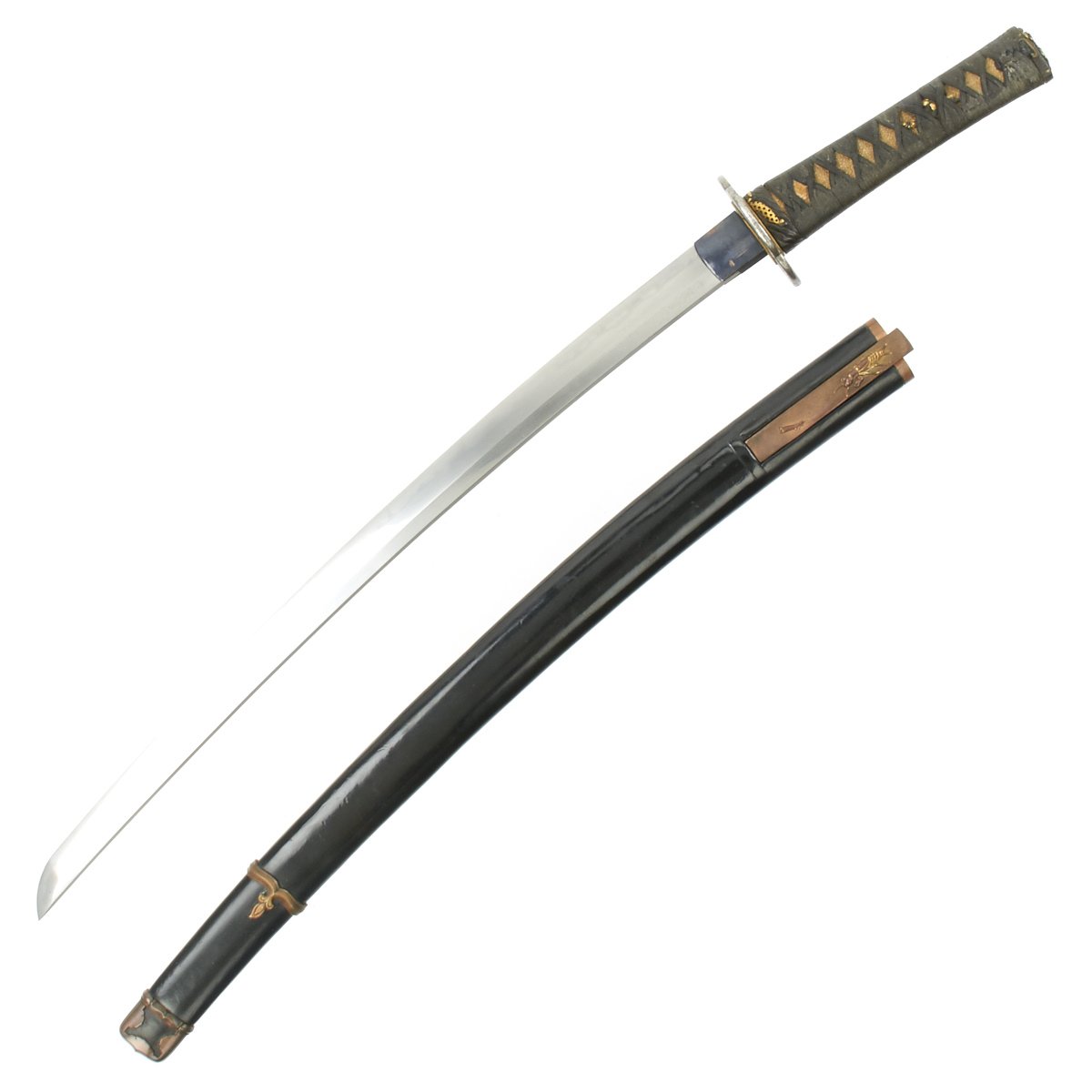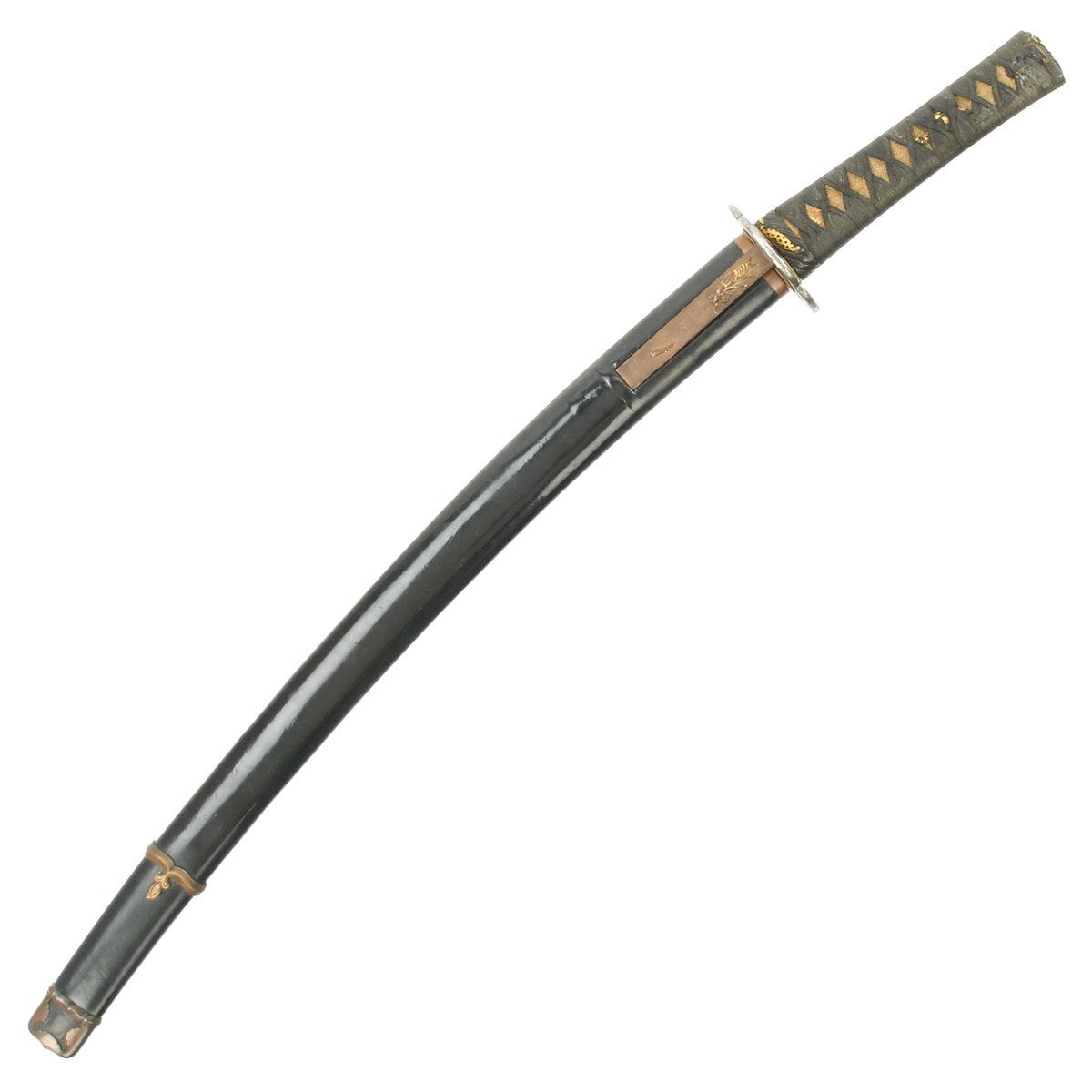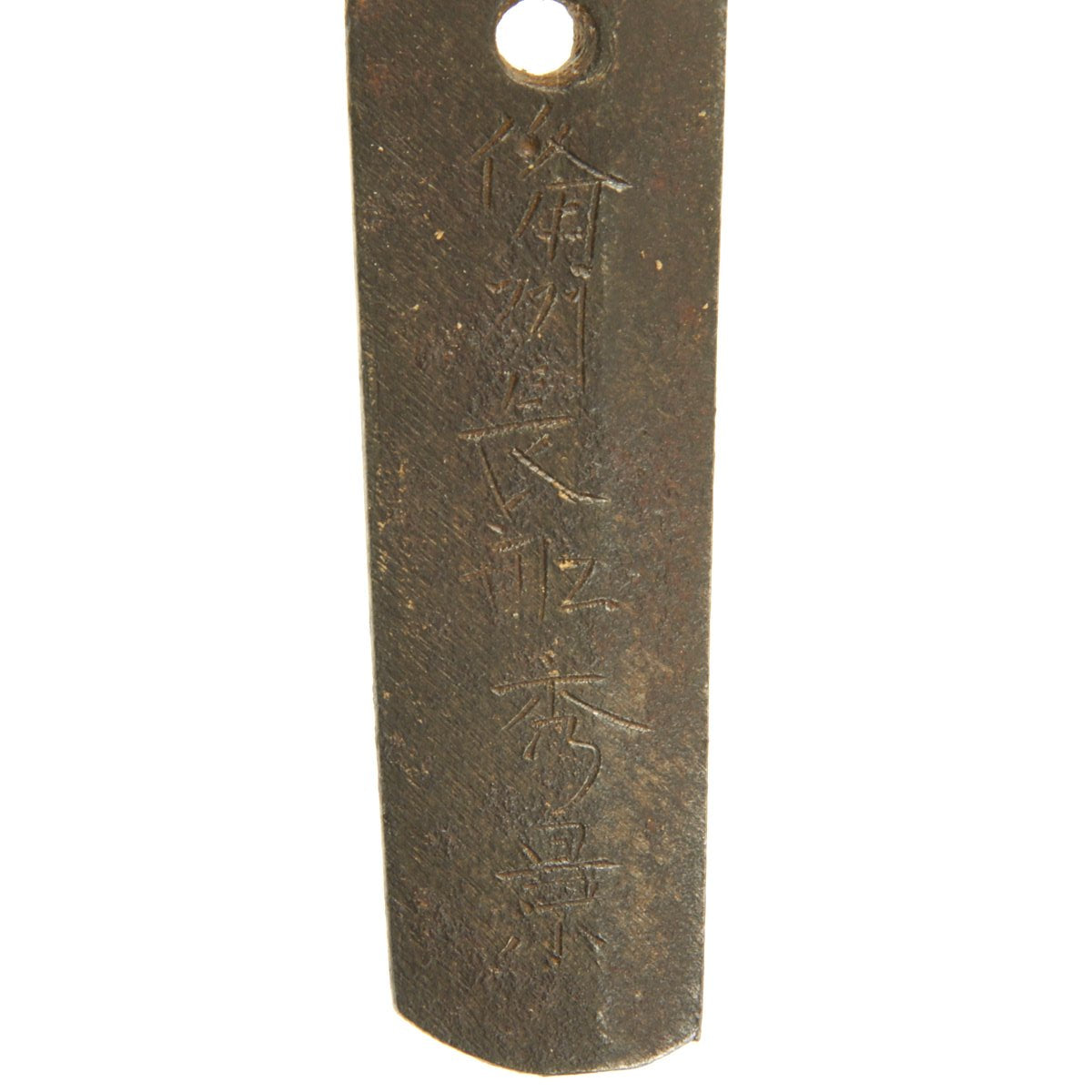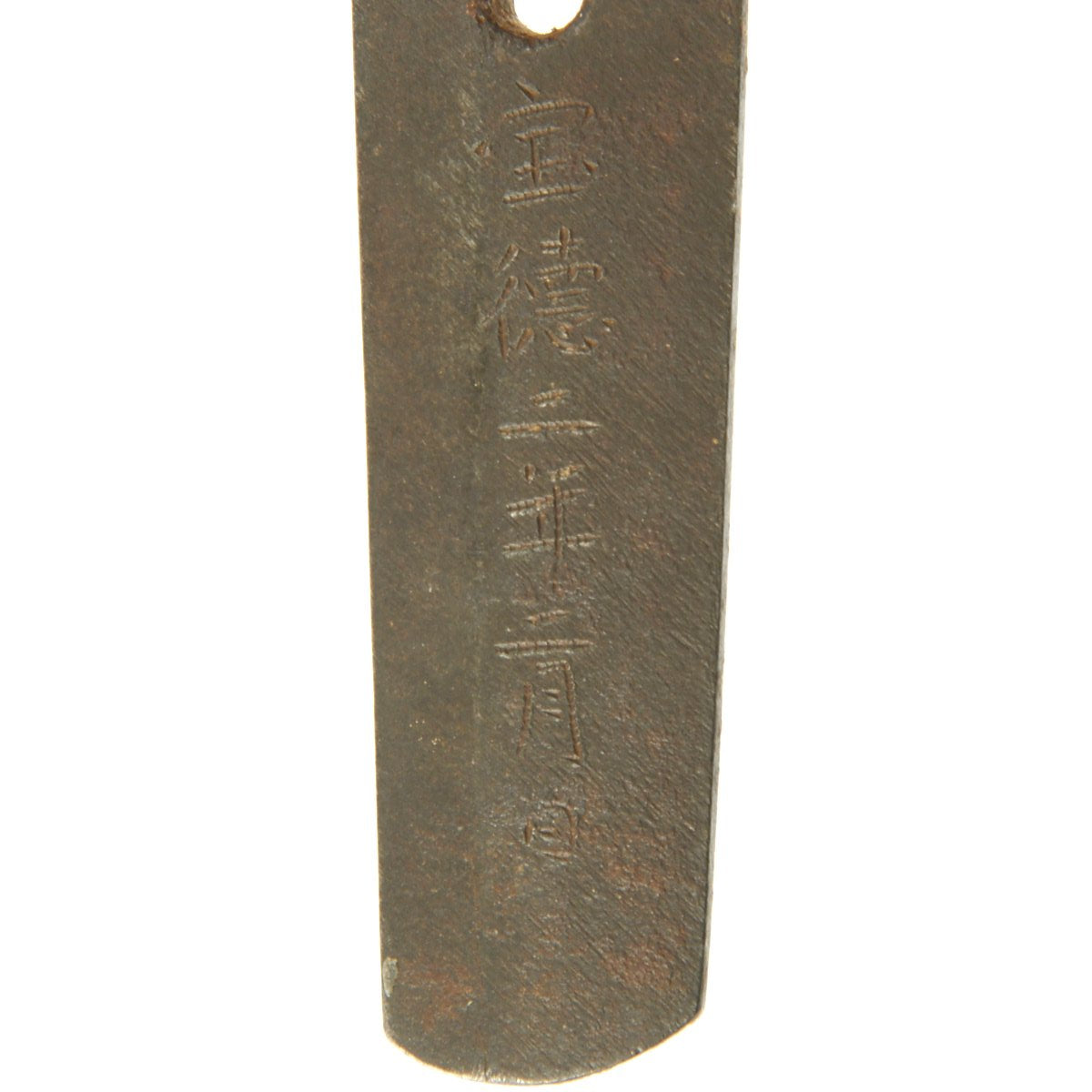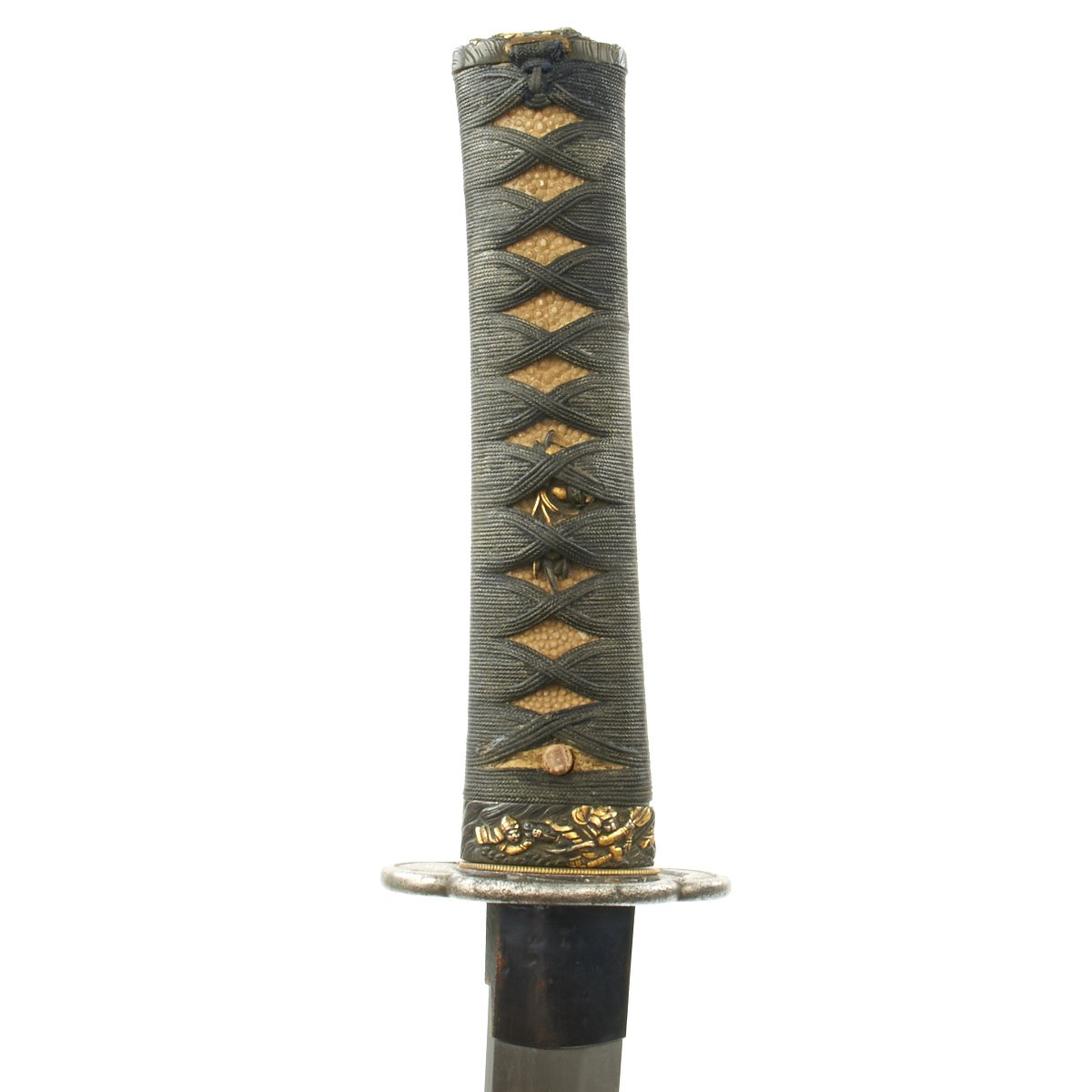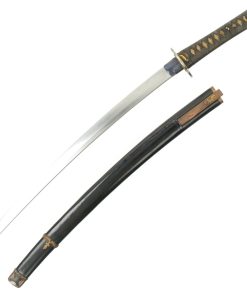Original 15th Century Japanese Wakizashi Sword by HIDEKAGE dated 1450 with Signed Kogatana Knife Original Items
$ 3.995,00 $ 998,75
Original Item: One of a kind. Wakizashi (脇差 “companion sword” or “side inserted sword”) is a general term for a sword between one and two shaku long (30 cm and 60 cm), predominantly made after 1600. However, blades of all lengths were made for centuries, and classified later. Generally it is the short blade that accompanies a katana (刀) in the traditional samurai daisho pairing of swords, but may be worn by classes other than the samurai as a single blade, also worn edge up as the katana. This example is 27 in overall length, and has a lovely black lacquered scabbard with copper fittings. This is one of the best and oldest we have ever seen, with an incredible blade, high quality fittings, and even a signed kogatana knife. If you’ve been waiting for a great Kotō period Japanese short sword, this may be what you’re looking for.
The blade of this Wakizashi is signed on one side by the maker: 備 州 長 船 秀 景 – BISHU OSAFUNE HIDEKAGE. This smith was known to be active in the mid 15th Century. The other side has a clear date on the blade tang (nengo), indicating when it was produced. It is written in the standard long form indicating years into the current emperor’s reign: 宝 徳 二 年 二 月. This would be read: HO-TOKU ( Japanese Era Name) Ni Nen (2nd year of era – 1450) Ni Gatsu (2nd Month). We checked numerous character charts, and reading them can be challenging, as they are chiseled in, and often barely resemble written kanji. However, the second character is undoubtedly 徳 (toku), and with that knowledge we narrowed it down to the first character being 宝 (Ho). Reading Japanese mei (blade markings) is always an involved process.
This is complicated by earlier Emperors of Japan having multiple Japanese era names (後花園天皇) during their reign. This period was during the reign of Emperor Go-Hanazono (後花園天皇), who was the reigning Emperor of Japan from 1428 through 1464. Also at this time the months did not coincide with the Western Calendar at this time.
We were not able to translate the signature (mei), making this an excellent research opportunity. Blades this old require specialized knowledge, as the names of provinces and the actual characters used have changed over the centuries.
The blade of this incredible piece measures 19.5″ and is finely made with high polish, and a sharp edge. It has the following period correct features for an ancient blade:
– Folded steel blade (fold lines are evident on the spine and body of the blade)
– Visible grain (“hada”) in the steel of the blade with nie and nioi crystal structure visible.
– Blade lamination artifacts (“kizu”) from carbon pockets introduced during the original folding process.
– Holes in the tang (“mekugi-ana”) are punched and not machine drilled. There are two holes, from various times it was mounted.
-Highly visible temper line (“hamon”) of the billowing (“touran”) type. Holding the blade to the light helps see the details.
-Maker signed blade tang (“mei”) with date (“nengo”) on the reverse.
Offered in near excellent condition this wakizashi blade is still sharp and nick free. The yokote is well defined, and the hamon the proper milky texture. There is little corrosion, if any, visible on the blade. The polish is slightly worn, but still quite nice. There is also a Kogatana (小刀) with this wakizashi, with a and highly decorative handle (kozuka). The Kogatana has some corrosion on the blade, but is still sharp.
What really sets this particular Wakizashi apart is the quality and design of the fittings. The Mokko Gatta shaped (like a sliced quince) tsuba (cross guard) is of iron construction, with faded gold highlights, and a mostly open design. The habaki (blade collar) is blacked copper, common for early period blades. The Tsuka (handle) has an excellent stingray (Sa-Me) grip with complete Ito (cloth binding). The Kashira (end cap) is brass and copper, and embossed in gold with the image of a Samurai. This design matches the style of the Fuchi (grip collar), which also is brass with gold highlighted warrior motifs. There are two seppa (spacers) around the cross guard, and the wooden securing peg is still present, though due to wear and shrinkage the grip is just a bit loose on the tang.
The menuki (grip decorations) on this wakizashi are brass, and are gold highlighted, though we cannot make out the design due to the wrappings. The handle of the Kogatana (kozuka), which is copper with gold highlights, shows a cricket and a damselfly nymph, from what we can see. The black lacquered scabbard is in great condition, with a solid kurikata (knob) where a sageo (cord) could be attached to the scabbard. This would be used to attach the scabbard to the clothing for use.
The fittings and blade quality of this 15th century Wakizashi make it one of the best that we have ever had. It would make a worthy addition to any Japanese collection, if not the centerpiece.
It has been over one thousand years ago that the art of making swords appeared in Japan. The swordsmiths of the time may not have known it but they were creating a legendary sword. The Samurai sword has seen combat in many battlefields. From the early days of the Samurai warrior to the fierce battles in the South Pacific during WWII.
Each hand-made Samurai sword is unique because it is forged from multiple pieces of folded steel stock. A tremendous amount of work is dedicated to creating these pieces. They were an instrument of war as much as a beautiful artifact to adorn a room.
The Samurai sword has grown to be one of the most highly desired military antiques.
Fast Shipping with Professional Packaging
Thanks to our longstanding association with UPS FedEx DHL, and other major international carriers, we are able to provide a range of shipping options. Our warehouse staff is expertly trained and will wrap your products according to our exact and precise specifications. Prior to shipping, your goods will be thoroughly examined and securely secured. We ship to thousands clients each day across multiple countries. This shows how we're dedicated to be the largest retailer on the internet. Warehouses and distribution centres can be located throughout Europe as well as the USA.
Note: Orders with more than one item will be assigned a processing date depending on the item.
Before shipping before shipping, we'll conduct a thorough inspection of the items you have ordered. Today, the majority of orders will be delivered within 48 hours. The delivery time will be between 3-7 days.
Returns
The stock is dynamic and we cannot completely manage it because multiple stakeholders are involved, including our factory and warehouse. So the actual stock may alter at any time. It's possible that you may not receive your order once the order has been made.
Our policy is valid for a period of 30 days. If you don't receive the product within 30 days, we are not able to issue a refund or an exchange.
You can only return an item if it is unused and in the same state as the day you received it. You must have the item in its original packaging.
Related products
Uncategorized
Uncategorized
Uncategorized
Uncategorized
Uncategorized
Uncategorized
Uncategorized
Uncategorized
Uncategorized
Australian WWII Owen MK1 Machine Carbine SMG Custom Fabricated Replica with Sling Original Items
Uncategorized
Uncategorized
Band of Brothers ORIGINAL GERMAN WWII Le. F.H. 18 10.5cm ARTILLERY PIECE Original Items
Uncategorized
Uncategorized
Uncategorized
Uncategorized
Angolan Rebel 1970s era 60mm Inert Display Mortar from Angolan Civil War Original Items
Uncategorized
Uncategorized
Uncategorized
Uncategorized
